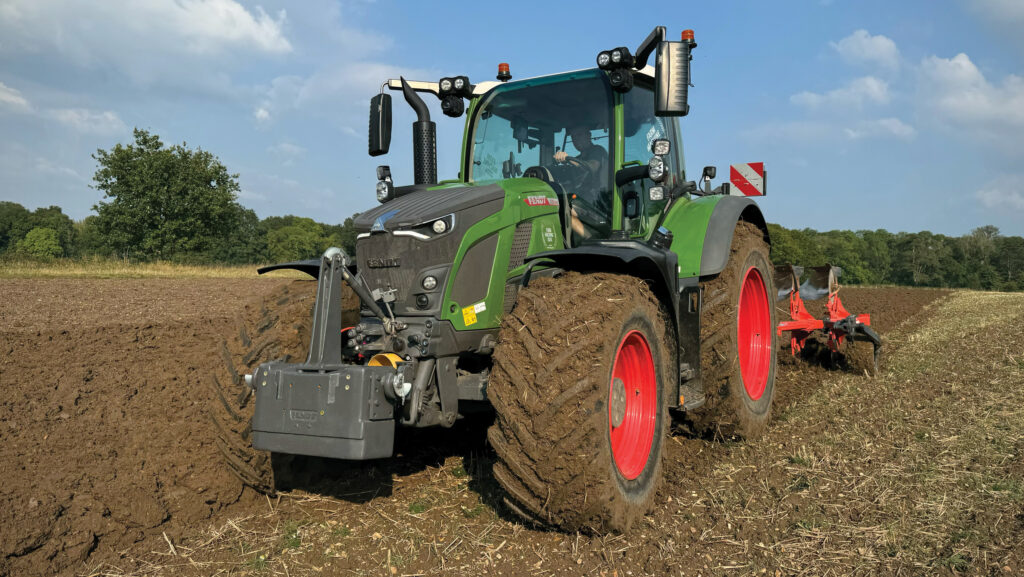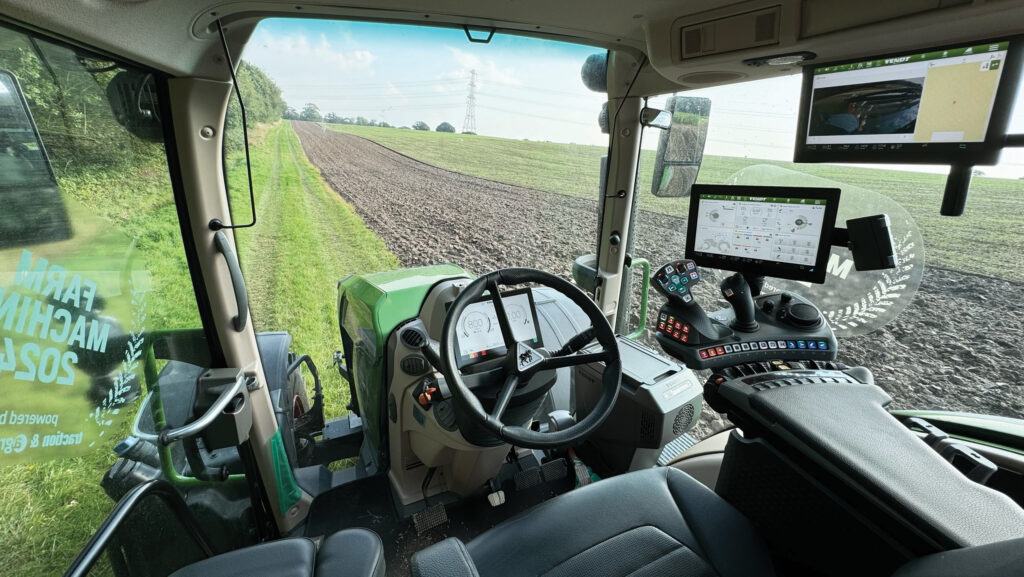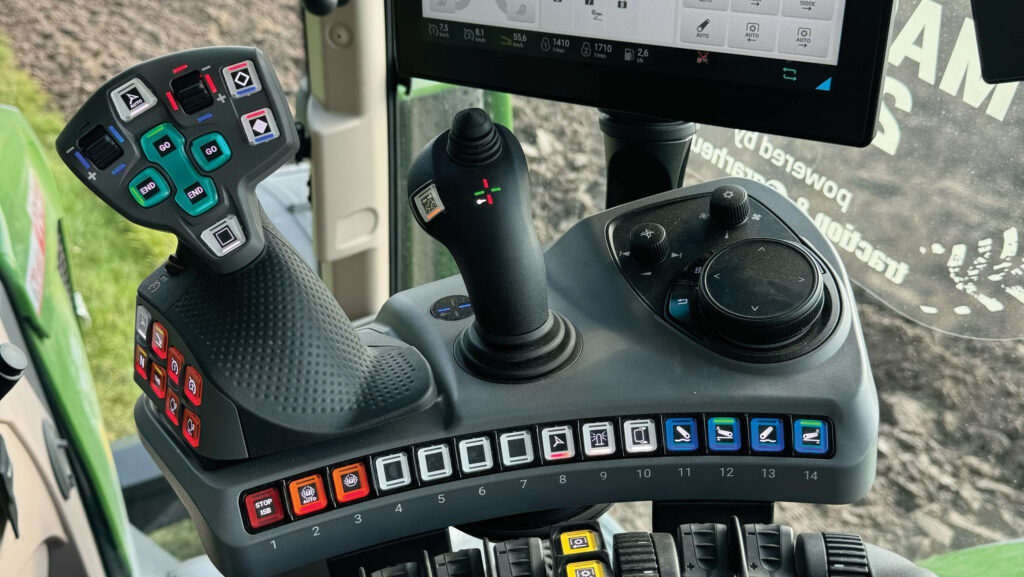On test: Fendt’s four-cylinder, 224hp 620 – small engine, big power
 © MAG/Oliver Mark
© MAG/Oliver Mark Four cylinders? 224hp? It’s hard to believe just what can be wrung from a relatively small engine these days – one that finds itself propelling the successors to Fendt’s uber-popular Gen 6 700 series.
Top dog in the new 600 Vario range, it punches above its weight like a feisty Jack Russell, with its maximum output a new record as far as four-potters go, handsomely trumping stablemate Valtra’s 201hp N175.
See also: First impressions: New £250,000 Fendt 728 lands on UK soil
But the company will have its work cut out to convince 700 series customers that it’s not all about sheer cubic capacity.
After all, six-potters are as much a British farming staple as wax jackets and Schöffel fleeces.
From Ford’s 105hp 7810 to John Deere’s eternally popular 6930, six has long been the magic number as far as frontline field tractors are concerned.
The 620 could change that, though. It’s torquier than an equivalent 720, rated to carry just as much, and squishes the lot into a more compact frame.
Fendt 620 Vario
- Engine 5-litre, four-cylinder Agco
- Max power 224hp
- Max torque 950Nm
- Transmission Single-range TA 150 (50kph)
- Lift capacity 9,790kg rear; 4,400kg front
- Hydraulics 152 litre/min (205 litre/min option)
- Wheelbase 2,720mm
- Turning circle 10.2m
- Operating weight 7,740kg
- Gross vehicle weight 13.5t
- Base list price £236,543
- List price as tested (Profi+) £290,000
Where does it fit in?
Fendt ’s mid-size tractor offering is all sixes and sevens – literally and metaphorically.
This jumble was caused by introducing a new 700 series (Gen 7) two years ago but not having the minerals to cull the old ones (Gen 6).
No surprise really – 48% of all Fendt tractors sold in the UK last year were Gen 6 700s.
To offset the damage of this seemingly self-sabotaging act, the old Sevens are going through the softest of soft withdrawals.
Only the unpopular 714 and 716 have been discontinued thus far, and even they are still available to buy.
So, we’ve got 500s (131-171hp), 600s (164-224hp) and Gen 7 700s (203-303hp), plus the hangers-on from the Gen 6 700s (188-246hp, excluding the two smallest models).
All a bit messy and very un-German.
There are four new 600s – even numbers from the 614 to the 620 – that appear, stats-wise, legitimate replacements for most of the old 700s.
However, the only natural successor to the Gen 6 724 is a Gen 7 version.
Going forward, Fendt is confident Sixes will eventually outsell Sevens.
By its reckoning, plenty of 720, 722 and 724 customers don’t need the power they’ve got, will likely value the smaller chassis and improved manoeuvrability that goes with it.
They will no doubt be charmed by all the technology – not least the single-range transmission with automatic four-wheel drive.
Can it compete with a six-cylinder?
There’s no reason why not, particularly as the Agco engine has been designed specifically for the job.
It’s only available on Bavarian tractors – Massey Ferguson and Valtra will have a long wait for the hand-me-downs.
True to its Sisu heritage, Agco has given the 5-litre Core 50 block larger cylinders than the average four-potter.
This makes it surprisingly torquey, with the 620’s 950Nm peak coming at a lowly 1,200-1,600rpm and bettering the equivalent 720 Gen 6 by some 39Nm.
All 600s also get Fendt’s “Dynamic Performance” (DP) system – something usually reserved for the top model in each range.
This sophisticated engine boost works differently to that of other tractors.
Rather than being restricted to high transport speeds and reasonable pto loads, DP fires into action in response to modest power draws from the ancillaries – air-conditioning, compressor, work lights and the like.
It can provide up to 15hp to the 620’s pre-boost 209hp maximum, no matter whether it’s moving or stationary.
The other powertrain detail of note is the lack of an exhaust gas recirculation system. This helps keep the engine temperature low but does increase AdBlue consumption.
High power, low weight
Two of the stand-out attractions of the 700 series tractors are their manoeuvrability and modest weight.
And the 620 is even better in these regards, as it sits on a shorter, lighter chassis.
Operating weight is down 500kg to 7.7t, resulting in a power-to-weight ratio of just 34.4kg/hp. By comparison, that figure stands at 39.2kg/hp on the Gen 6 720.
Yet it’s still rated to the same 13.5t gross payload, leaving a useful 5.8t of carrying capacity.
This compact, heavy lifting design has plenty of perks, reducing soil compaction on lightweight jobs and increasing the amount it can tow on the road without breaching weight limits.
It’ll also suit any tasks involving front and rear implement combinations, such as triple mowers or drills with separate hoppers, which naturally balance the tractor.
However, for solely rear-mounted implements, particularly heavy cultivators, it needs meaty ballast to avoid running out of grip.
New transmission
As well as the new engine, the 620 gets a fresh Variodrive transmission, with the old ML two-range CVT having been handed down to Agco’s subordinate brands.
The TA 150 is effectively a downsized version of the TA 190 in the new 700s, and it’s seriously sophisticated.
For starters, this full-time four-wheel drive system has separate hydraulic motors for the two axles, allowing them to work independently.
Sensors monitor their slip and automatically vary the amount of torque sent front and rear to maintain traction.
As a result, there’s no 4WD button for drivers to push in the cab.
And because the transmission is now a single-range setup, there’s no need to stress about switching from field to road modes before setting out on the asphalt.
Once they reach 25kph, a central clutch automatically decouples the drive to the front axle. This reduces engine load and fuel consumption to hit 50kph at a frugal 1,250rpm.
But perhaps one of the best features of this drivetrain is the ability of the front wheels to speed up during cornering to actively drag the tractor around a bend.
According to Fendt, this carves 10% off the turning circle.
It’s 10.2m on 540/65 R30 tyres, down from 10.8m on a Gen 6 700, and noticeably scuff free, which saves both churning up headlands and leaving black skiddies on concrete yards.
If that’s not enough, then buyers can splurge on an integrated central tyre inflation system.
Its twin-piston pump has enough puff to up the pressures to suit road transport in a couple of minutes.
It’s not cheap, though. The system alone adds nearly £10,000 to the list price, plus about half that again for flexi-walled VF tyres.

© MAG/Oliver Mark
Cab
There’s practically nothing to dislike about a top-spec Fendt cab, provided you can get over the overwhelming sight of space shuttle-style controls.
Operating the Starship does require some IT skills, but the system is slightly easier to use than older iterations – even for Fendt rookies.
The same cab is fitted to all 300, 500, 600 and 700-series tractors – including Gen 6s – so most buyers will know what they’re in for.
Views are superb, with the bonnet low and gently sloping, and the windscreen swooping into the roof.
It’s worth giving due consideration to the specification, though.
Where once the vast majority of Fendts were sold in top Profi+ guise, incessant price rises are bringing simpler versions to the fore.
Power+, two rungs down, is about £12,000 cheaper yet adequate for most, particularly as far as hydraulic outlets go – four rear, one front and three loader mid-mounts.
Only owner-operators can truly justify treating themselves to the fanciest setup, with its electrically adjustable, heating/cooling/massaging seat.

© MAG/Oliver Mark
FW verdict
The 620 comes with everything you expect from Fendt – slick transmission, posh cab, and a big price.
The switch to four cylinders saves around £5,000 versus the Gen 6 720 and, thanks to its engine boost function, there’s an extra 15hp to play with.
Our first impressions are that customers won’t feel short-changed.
But whether they can be convinced is the million-dollar question – particularly with John Deere’s super-popular 204/234hp 6R 185 (6.8-litre, six-cylinder) waiting in the wings.
Likes and gripes
Likes
- Compact and powerful
- Quiet, comfortable cab
- Tight turning circle
Gripes
- Exorbitantly expensive in full spec
- Park brake inconveniently positioned and easy to forget
- Ballast essential for fieldwork

